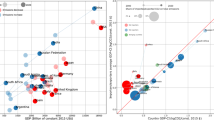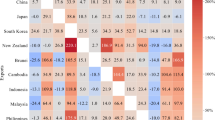Abstract
The Paris Agreement relies on nationally determined contributions to reach its targets and asks countries to increase ambitions over time, leaving open the details of this process. Although overcoming countries’ myopic ‘free-riding’ incentives requires cooperation, the global public good character of mitigation makes forming coalitions difficult. To cooperate, countries may link their carbon markets1, but is this option beneficial2? Some countries might not participate, not agree to lower caps, or not comply to agreements. While non-compliance might be deterred3, countries can hope that if they don’t participate, others might still form a coalition. When considering only one coalition whose members can leave freely, the literature following the publication of refs 4,5 finds meagre prospects for effective collaboration6. Countries also face incentives to increase emissions when linking their markets without a cap agreement7,8. Here, we analyse the dynamics of market linkage using a game-theoretic model of far-sighted coalition formation. In contrast to non-dynamic models and dynamic models without far-sightedness9,10, in our model an efficient global coalition always forms eventually if players are sufficiently far-sighted or caps are coordinated immediately when markets are linked.
This is a preview of subscription content, access via your institution
Access options
Access Nature and 54 other Nature Portfolio journals
Get Nature+, our best-value online-access subscription
$29.99 / 30 days
cancel any time
Subscribe to this journal
Receive 12 print issues and online access
$209.00 per year
only $17.42 per issue
Buy this article
- Purchase on Springer Link
- Instant access to full article PDF
Prices may be subject to local taxes which are calculated during checkout




Similar content being viewed by others
Change history
19 April 2018
In the PDF version of this Article originally published, in equation (6) \(g^{\prime}_{i}\) was incorrectly formatted as gi′, and at the end of the Methods section w i was incorrectly formatted as wi. These have now been corrected.
References
Adoption of the Paris Agreement FCCC/CP/2015/L.9/Rev.1 (UNFCCC, 2015); http://unfccc.int/resource/docs/2015/cop21/eng/l09r01.pdf
Green, J. F., Sterner, T. & Wagner, G. A balance of bottom-up and top-down in linking climate policies. Nat. Clim. Change 4, 1064–1067 (2014).
Heitzig, J., Lessmann, K. & Zou, Y. Self-enforcing strategies to deter free-riding in the climate change mitigation game and other repeated public good games. Proc. Natl Acad. Sci. USA 108, 15739–15744 (2011).
Carraro, C. & Siniscalco, D. Strategies for the international protection of the environment. J. Public Econ. 52, 309–328 (1993).
Barrett, S. Self-enforcing international environmental agreements. Oxford Econ. Pap. 46, 878–894 (1994).
Finus, M. in Environmental Policy in an International Perspective (eds Marsiliani, L., Rauscher, M. & Withagen, C.) 19–49 (Kluwer, Dordrecht, Holland, 2003).
Helm, C. International emissions trading with endogenous allowance choices. J. Public Econ. 87, 2737–2747 (2003).
Carbone, J. C., Helm, C. & Rutherford, T. F. The case for international emission trade in the absence of cooperative climate policy. J. Environ. Econ. Manag. 58, 266–280 (2009).
Smead, R., Sandler, R. L., Forber, P. & Basl, J. A bargaining game analysis of international climate negotiations. Nat. Clim. Change 4, 442–445 (2014).
Verendel, V., Johansson, D. J. A. & Lindgren, K. Strategic reasoning and bargaining in catastrophic climate change games. Nat. Clim. Change 6, 6–10 (2015).
Ray, D. & Vohra, R. Equilibrium binding agreements. J. Econ. Theory 73, 30–78 (1997).
Ray, D. & Vohra, R. A theory of endogenous coalition structures. Games Econ. Behav. 26, 286–336 (1999).
Konishi, H. & Ray, D. Coalition formation as a dynamic process. J. Econ. Theory 110, 1–41 (2003).
de Zeeuw, A. Dynamic effects on the stability of international environmental agreements. J. Environ. Econ. Manag. 55, 163–174 (2008).
Biancardi, M. & Villani, G. Largest consistent set in international environmental agreements. Comput. Econ. 38, 407–423 (2011).
Osmani, D. A Note on Computational Aspects of Far-sighted Coalitional Stability. Hamburg University, Sustainability and Global Change Research Unit Working Papers FNU–176 1–18 (2011).
Godal, O. & Holtsmark, B. On the efficiency gains of emissions trading when climate deals are non-cooperative. Bergen Inst. Res. Econ. Bus. Adm. Work. Pap. 17, 1–24 (2011).
Flachsland, C., Marschinski, R. & Edenhofer, O. To link or not to link: benefits and disadvantages of linking cap-and-trade systems. Clim. Policy 9, 358–372 (2009).
Tuerk, A., Mehling, M., Flachsland, C. & Sterk, W. Linking carbon markets: concepts, case studies and pathways. Clim. Policy 9, 341–357 (2009).
Jaffe, J. & Stavins, R. N. L inkage of Tradable Permit Systems in International Climate Policy Architecture. NBER Working Paper 14432 (2008).
Flachsland, C., Marschinski, R. & Edenhofer, O. Global trading versus linking: Architectures for international emissions trading. Energy Policy 37, 1637–1647 (2009).
Ranson, M. & Stavins, R. N. Linkage of greenhouse gas emissions trading systems: learning from experience. Clim. Policy 16, 284–300 (2016).
Ellerman, A. D. & Decaux, A. Analysis of Post-Kyoto CO 2 Emissions Trading Using Marginal Abatement Curves. MIT Joint Program on the Science and Policy of Global Change Report 40 (1998).
Finus, M., van Ierland, E. & Dellink, R. Stability of climate coalitions in a cartel formation game. Econ. Gov. 7, 271–291 (2006).
Kalai, E. Nonsymmetric Nash solutions and replications of 2-person bargaining. Int. J. Game Theory 6, 129–133 (1977).
Barrett, S. in Conflicts and Cooperation in Managing Environmental Resources (ed. Pethig, R.) 11–37 (Springer: Berlin, Heidelberg, 1992).
Heitzig, J. Efficiency in face of externalities when binding hierarchical agreements are possible. Game Theory Bargain. Theory eJournal 3, 1–16 (2011).
Heitzig, J. & Simmons, F. W. Some chance for consensus: Voting methods for which consensus is an equilibrium. Social. Choice Welf. 38, 43–57 (2012).
Nordhaus, W. D. Managing the Global Commons: the Economics of Climate Change (MIT Press, Cambridge, MA, 1994).
Nordhaus, W. D. Economic aspects of global warming in a post-Copenhagen environment. Proc. Natl Acad. Sci. USA 107, 11721–11726 (2010).
Kalai, E. & Samet, D. On weighted Shapley values. Int. J. Game Theory 16, 205–222 (1987).
Acknowledgements
The authors thank K. Lessmann, R. Marschinski, O. Edenhofer, the Policy Instruments Group and the COPAN Flagship Project at the Potsdam Institute for Climate Impact Research for many intense discussions; B. Holtsmark, M. Greaker, C. Hagem, R. Schmidt, and the CREW project for inspiring work; and R. Vohra, P. Menck, N. Marwan, J. Donges and C.-F. Schleussner for helpful comments.
Author information
Authors and Affiliations
Contributions
J.H. developed the model and conducted the numerical experiments. Both authors interpreted the study, and wrote and edited the text.
Corresponding author
Ethics declarations
Competing interests
The authors have no competing interests.
Additional information
Publisher’s note: Springer Nature remains neutral with regard to jurisdictional claims inpublished maps and institutional affiliations.
Supplementary information
Supplementary Information
Supplementary Methods, Supplementary Literature and Approaches, Supplementary Results, Supplementary References, Supplementary Figures 1–10, Supplementary Tables 1–2
Rights and permissions
About this article
Cite this article
Heitzig, J., Kornek, U. Bottom-up linking of carbon markets under far-sighted cap coordination and reversibility. Nature Clim Change 8, 204–209 (2018). https://doi.org/10.1038/s41558-018-0079-z
Received:
Accepted:
Published:
Issue Date:
DOI: https://doi.org/10.1038/s41558-018-0079-z



